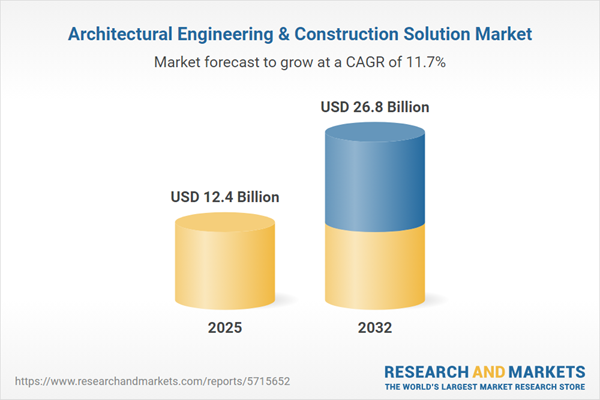Speak directly to the analyst to clarify any post sales queries you may have.
Senior decision-makers are redefining project delivery within the architectural engineering and construction solution market by accelerating digital transformation. Advanced technology integration now drives secure collaboration and agile risk management in a shifting project landscape.
Market Snapshot: Architectural Engineering & Construction Solution Market
The architectural engineering and construction solution market is undergoing steady expansion, supported by rising adoption of collaborative platforms and scalable cloud solutions. The need to coordinate complex, multi-party projects intensifies the focus on simulation and modeling technologies. These tools facilitate real-time coordination and promote project transparency, addressing increased complexity and regulatory fluidity across the sector. As businesses face evolving demands, the drive toward digitalization is enabling more aligned operational strategies, which future-proofs business models amid ongoing disruption and change.
Scope & Segmentation: Architectural Engineering & Construction Solution Market
- Solution Types: Includes Architectural BIM, MEP BIM, structural BIM, CAD (2D/3D), document management, communication, cost management, resource planning, scheduling, and simulation tools, offering support for diverse project stages and ensuring smooth progression from concept to completion.
- Deployment Modes: Options such as hybrid, public and private cloud, on-premises, and subscription licensing, enabling organizations to tailor deployment to security, compliance, and operational needs.
- Organization Size: Scalable digital platforms address the requirements of large enterprises, mid-sized organizations, small businesses, and micro firms, delivering adaptability to different operational scales and business priorities.
- End Users: Solutions serve architects, MEP engineers, structural engineers, contractors, and facility managers, fostering improved teamwork and project reliability within specialized construction roles.
- Geographic Regions: Adoption spans North America, Latin America, Europe, Middle East, Africa, and Asia-Pacific, with each region adapting solutions to local regulations, market needs, and project requirements.
- Key Companies Profiled: Industry leaders such as Autodesk, Nemetschek SE, Bentley Systems, Trimble Inc., Hexagon AB, Procore Technologies, Oracle Corporation, RIB Software SE, Dassault Systèmes SE, and AVEVA Group plc are central to trends in digital adoption and development of innovative construction technologies.
Clear segmentation enables organizations to select the right technology investments for their operational and sustainability objectives. Integration of Building Information Modeling (BIM) and CAD tools supports streamlined delivery and ongoing compliance with shifting global environmental and regulatory standards affecting the construction industry.
Key Takeaways for Senior Decision-Makers
- Digital platforms strengthen collaborative workflows, enhancing communication and project supervision across distributed and interdisciplinary teams in the architectural engineering and construction solution market.
- Centralized document management makes it easier for teams to adapt to regulatory shifts and maintain project timelines within diverse geographical areas.
- Flexible technology infrastructures support operational agility, allowing organizations to adjust swiftly as project conditions change within complex market environments.
- Cloud-enabled solutions deliver extensive project visibility and robust resource control, maintaining consistent delivery among teams operating in multiple locations.
- Advanced simulation and modeling drive data-backed decision-making, assisting organizations in mitigating risks and maintaining stable operations as market dynamics evolve.
- Strategic alliances with technology providers encourage standardization of data practices and streamline processes, driving measurable improvements across all project stages.
Tariff Impact: Navigating Regulatory and Financial Challenges
With imminent U.S. tariffs on selected imported hardware and software by 2025, market participants are reevaluating sourcing and deployment. Focus is shifting toward leasing and cloud-first models, tightening financial planning and reducing organizational vulnerability. These approaches also enhance supply chain stability, reinforce vendor relationships, and enable uninterrupted business operations despite evolving regulatory demands.
Methodology & Data Sources
This analysis leverages rigorous secondary research, expert interviews, practitioner surveys, and structured validation tools to ensure accuracy. The methodology delivers actionable and dependable market insights for senior stakeholders tracking construction technology trends.
Why This Report Matters
- Senior leaders can guide strategic digital transformation, advancing business resilience and competitive alignment within the construction sector.
- Procurement managers access robust market intelligence to adapt procurement strategies and operational models as regulatory conditions change.
- Stakeholders across all market segments gain the insights necessary to identify emerging risks, optimize operations, and achieve sustainable growth.
Conclusion
This report equips senior decision-makers with clear, actionable intelligence to refine digital strategies and enhance project performance in the evolving architectural engineering and construction solution market.
Additional Product Information:
- Purchase of this report includes 1 year online access with quarterly updates.
- This report can be updated on request. Please contact our Customer Experience team using the Ask a Question widget on our website.
Table of Contents
3. Executive Summary
4. Market Overview
7. Cumulative Impact of Artificial Intelligence 2025
List of Figures
Companies Mentioned
The companies profiled in this Architectural Engineering & Construction Solution market report include:- Autodesk, Inc.
- Nemetschek SE
- Bentley Systems, Incorporated
- Trimble Inc.
- Hexagon AB
- Procore Technologies, Inc.
- Oracle Corporation
- RIB Software SE
- Dassault Systèmes SE
- AVEVA Group PLC
Table Information
| Report Attribute | Details |
|---|---|
| No. of Pages | 184 |
| Published | November 2025 |
| Forecast Period | 2025 - 2032 |
| Estimated Market Value ( USD | $ 12.4 Billion |
| Forecasted Market Value ( USD | $ 26.8 Billion |
| Compound Annual Growth Rate | 11.6% |
| Regions Covered | Global |
| No. of Companies Mentioned | 10 |









